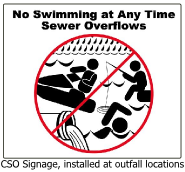CSOcast
Overview

How It Works
The Philadelphia Water Department has maintained an extensive flow monitoring network since 1995. Level sensors record data throughout the combined sewer system. PWD currently operates and maintains monitoring equipment at, or near, the 164 CSOs throughout the city. This public notification system is based on PWD analysis of monitoring network data which is used to determine the likelihood of combined sewer overflows.
Flow monitoring data presented on this web page is validated with the Philadelphia watershed and wastewater conveyance model. The model was developed using U.S. EPA’s Storm Water Management Model (SWMM). Real time rainfall data is taken from the PWD rain gage network and run through the model to estimate where and when overflows are occurring. Model output is then used to validate the monitoring data, ensuring a second level of accuracy.
Information on this site is updated daily. If an outfall reports that no overflow is occurring, but it is still raining, there is the potential that an overflow is indeed occurring. It is always safest to avoid aquatic recreation during rainfall events.
For more information on how to use the map on this page, click here.

|
Zoom to a river/creek:
Search for your address:
(Example: 1101 Market St) |
Disclaimer
The Philadelphia Combined Sewer Overflow Public Notification System (CSOCast) is a pilot program. PWD is constantly updating and improving not only the notification system, but the flow monitoring network and SWMM Model, in order to deliver the best information possible to the public.
Flow monitoring is a difficult task that requires constant maintenance of the city-wide sensor network. Because the monitoring system is so extensive, it should be assumed some monitors may occasionally report inaccurate information and sometimes no information at all.
Additionally, a watershed and wastewater conveyance model is only an estimate of actual conditions. The model is calibrated to real data to achieve a high level of accuracy; however, it should be understood that a certain level of error will always be present. Recent changes in the land use (for example, a new park constructed in place of a parking lot) will not be reflected in CSOcast until the model is updated. As Philadelphia becomes greener and overflows are reduced, the model will in turn be updated to new conditions.
Learn more about the SWMM modeling software.
Feedback
Please let us know how this system is working for you.
Questions or comments regarding information presented on CSOcast should be directed to edward.lennonjr@phila.gov